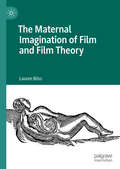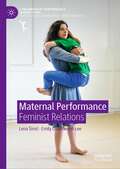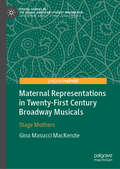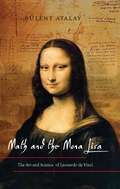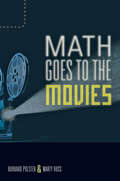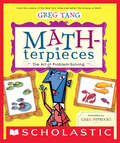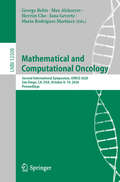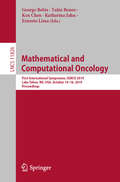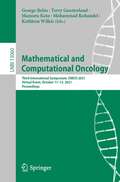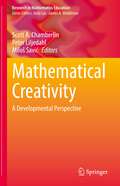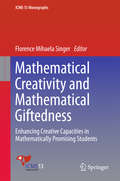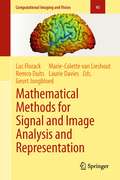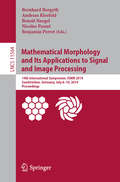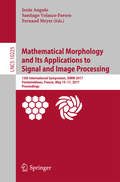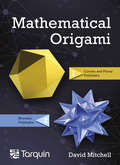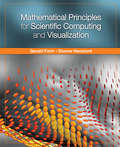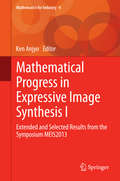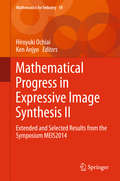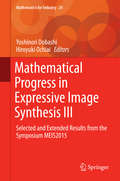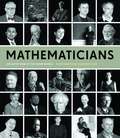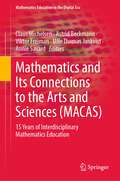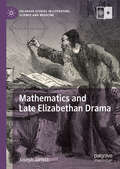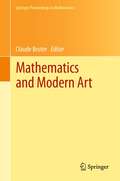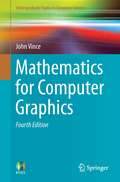- Table View
- List View
The Maternal Imagination of Film and Film Theory
by Lauren BlissThis book challenges common sense understandings of the unconscious effects of cinema and visual culture. It explores the castrating power of the early modern witch and the historical belief that pregnant women could manipulate and distort body image as figurative analogies for feminist theories of objectification and the male gaze. Through developing this history as an impure but lively analogy, this book serves as a provocation against the dominant imagining of objectification. It offers innovative analyses of a wide-ranging selection of films and topics including Joyce Wieland’s Water Sark (1964) and its resonance with the works of John Cage and Stan Brakhage; the documentary Histoires d’A (History of Abortion, 1973), which contributed to the successful legalisation of abortion in France; the Hong Kong horror film Dumplings (Jiaozi, 餃子 2004), where foetal cannibalism serves up an image of censorship; and the dual productions The Book of Mary (Le livre de Marie) and Hail Mary (Je vous salue, Marie, 1985) by Anne-Marie Miéville and Jean-Luc Godard that figure a self-reproducing virgin who hears herself while remaining a virgin, unseen.
Maternal Performance: Feminist Relations (Contemporary Performance InterActions)
by Lena Šimić Emily Underwood-LeeMaternal Performance: Feminist Relations bridges the fields of performance, feminism, maternal studies, and ethics. It loosely follows the life course with chapters on maternal loss, pregnancy, birth, aftermath, maintenance, generations, and futures. Performance and the maternal have an affinity as both are lived through the body of the mother/artist, are played out in real time, and are concerned with creating ethical relationships with an other – be that other the child, the theatrical audience, or our wider communities. The authors contend that maternal performance takes the largely hidden, private and domestic work of mothering and makes it worthy of consideration and contemplation within the public sphere.
Maternal Representations in Twenty-First Century Broadway Musicals: Stage Mothers (Pivotal Studies in the Global American Literary Imagination)
by Gina Masucci MacKenzieMaternal Representations in Twenty-First Century Broadway Musicals: Stage Mothers analyzes Broadway productions within the context of their presentation and assessment of motherhood and the variety of roles for mother figures. Using a frame of feminist and psychoanalytical positions, Gina MacKenzie establishes, defines, and interprets mother figures in contemporary Broadway, according to original categorizations of the absent, inconsequential, and overbearing mothers. MacKenzie considers how and why commercial representation of mother figures are limited and predominantly negative, even as fiction, poetry, and other forms of drama offer a much wider and progressive view of the varieties of motherhood possible in society, asserting the need for greater representation of mother figures in commercial musical theatre today.
Math and the Mona Lisa: The Art and Science of Leonardo da Vinci
by Bulent AtalayLeonardo da Vinci was one of history's true geniuses, equally brilliant as an artist, scientist, and mathematician. Readers of The Da Vinci Code were given a glimpse of the mysterious connections between math, science, and Leonardo's art. Math and the Mona Lisa picks up where The Da Vinci Code left off, illuminating Leonardo's life and work to uncover connections that, until now, have been known only to scholars. Bülent Atalay, a distinguished scientist and artist, examines the science and mathematics that underlie Leonardo's work, paying special attention to the proportions, patterns, shapes, and symmetries that scientists and mathematicians have also identified in nature. Following Leonardo's own unique model, Atalay searches for the internal dynamics of art and science, revealing to us the deep unity of the two cultures. He provides a broad overview of the development of science from the dawn of civilization to today's quantum mechanics. From this base of information, Atalay offers a fascinating view into Leonardo's restless intellect and modus operandi, allowing us to see the source of his ideas and to appreciate his art from a new perspective.From the Hardcover edition.
Math Goes to the Movies
by Burkard Polster Marty RossMel Gibson teaching Euclidean geometry, Meg Ryan and Tim Robbins acting out Zeno's paradox, Michael Jackson proving in three different ways that 7 x 13 = 28. These are just a few of the intriguing mathematical snippets that occur in hundreds of movies. Burkard Polster and Marty Ross pored through the cinematic calculus to create this thorough and entertaining survey of the quirky, fun, and beautiful mathematics to be found on the big screen. Math Goes to the Movies is based on the authors' own collection of more than 700 mathematical movies and their many years using movie clips to inject moments of fun into their courses. With more than 200 illustrations, many of them screenshots from the movies themselves, this book provides an inviting way to explore math, featuring such movies as:• Good Will Hunting• A Beautiful Mind• Stand and Deliver• Pi• Die Hard• The Mirror Has Two FacesThe authors use these iconic movies to introduce and explain important and famous mathematical ideas: higher dimensions, the golden ratio, infinity, and much more. Not all math in movies makes sense, however, and Polster and Ross talk about Hollywood's most absurd blunders and outrageous mathematical scenes. Interviews with mathematical consultants to movies round out this engaging journey into the realm of cinematic mathematics.This fascinating behind-the-scenes look at movie math shows how fun and illuminating equations can be.
Math-terpieces
by Greg Paprocki Greg TangNEW YORK TIMES bestselling author Greg Tang challenges kids to solve problems creatively while introducing art history.In his most ground-breaking book since THE BEST OF TIMES (Fall 2002), Greg Tang underscores the importance of four basic rules in problem-solving. Keeping an open mind, looking for unusual number combinations, using multiple skills (like subtracting to add) and looking for patterns, will guarantee any child success in math. In MATH-TERPIECES, Tang continues to challenge kids with his innovative approach to math, and uses art history to expand his vision for creative problem-solving.
Mathematical and Computational Oncology: Second International Symposium, ISMCO 2020, San Diego, CA, USA, October 8–10, 2020, Proceedings (Lecture Notes in Computer Science #12508)
by George Bebis Max Alekseyev Heyrim Cho Jana Gevertz Maria Rodriguez MartinezThis book constitutes the refereed proceedings of the Second International Symposium on Mathematical and Computational Oncology, ISMCO 2020, which was supposed to be held in San Diego, CA, USA, in October 2020, but was instead held virtually due to the COVID-19 pandemic.The 6 full papers and 4 short papers presented together with 1 invited talk were carefully reviewed and selected from 28 submissions. The papers are organized in topical sections named: statistical and machine learning methods for cancer research; mathematical modeling for cancer research; general cancer computational biology; and posters.
Mathematical and Computational Oncology: First International Symposium, ISMCO 2019, Lake Tahoe, NV, USA, October 14–16, 2019, Proceedings (Lecture Notes in Computer Science #11826)
by George Bebis Takis Benos Ken Chen Katharina Jahn Ernesto LimaThis book constitutes the refereed proceedings of the First International Symposium on Mathematical and Computational Oncology, ISMCO'2019, held in Lake Tahoe, NV, USA, in October 2019. The 7 full papers presented were carefully reviewed and selected from 30 submissions. The papers are organized in topical sections named: Tumor evolvability and intra-tumor heterogeneity; Imaging and scientific visualization for cancer research; Statistical methods and data mining for cancer research (SMDM); Spatio-temporal tumor modeling and simulation (STTMS).
Mathematical and Computational Oncology: Third International Symposium, ISMCO 2021, Virtual Event, October 11–13, 2021, Proceedings (Lecture Notes in Computer Science #13060)
by George Bebis Terry Gaasterland Mamoru Kato Mohammad Kohandel Kathleen WilkieThis book constitutes the refereed proceedings of the Third International Symposium on Mathematical and Computational Oncology, ISMCO 2021, held in October 2021. Due to COVID-19 pandemic the conference was held virtually.The 3 full papers and 4 short papers presented were carefully reviewed and selected from 20 submissions. The papers are organized in topical sections named: statistical and machine learning methods for cancer research; mathematical modeling for cancer research; spatio-temporal tumor modeling and simulation; general cancer computational biology; mathematical modeling for cancer research; computational methods for anticancer drug development.
Mathematical Creativity: A Developmental Perspective (Research in Mathematics Education)
by Scott A. Chamberlin Peter Liljedahl Miloš SavićThis book is important and makes a unique contribution in the field of mathematics education and creativity. The book comprises the most recent research by renowned international experts and scholars, as well as a comprehensive up to date literature review. The developmental lens applied to the research presented makes it unique in the field. Also, this book provides a discussion of future directions for research to complement what is already known in the field of mathematical creativity. Finally, a critical discussion of the importance of the literature in relation to development of learners and accordingly pragmatic applications for educators is provided. Many books provide the former (2) foci, but omit the final discussion of the research in relation to developmental needs of learners in the domain of mathematics. Currently, educators are expected to implement best practices and illustrate how their adopted approaches are supported by research. The authors and editors of this book have invested significant effort in merging theory with practice to further this field and develop it for future generations of mathematics learners, teachers and researchers.
Mathematical Creativity and Mathematical Giftedness: Enhancing Creative Capacities In Mathematically Promising Students (ICME-13 Monographs)
by Florence Mihaela SingerThis book discusses the relationships between mathematical creativity and mathematical giftedness. It gathers the results of a literature review comprising all papers addressing mathematical creativity and giftedness presented at the International Congress on Mathematical Education (ICME) conferences since 2000. How can mathematical creativity contribute to children’s balanced development? What are the characteristics of mathematical giftedness in early ages? What about these characteristics at university level? What teaching strategies can enhance creative learning? How can young children’s mathematical promise be preserved and cultivated, preparing them for a variety of professions? These are some of the questions addressed by this book. The book offers, among others: analyses of substantial learning environments that promote creativity in mathematics lessons; discussions of a variety of strategies for posing and solving problems; investigations of students’ progress throughout their schooling; and examinations of technological tools and virtual resources meant to enhance learning with understanding. Multiple perspectives in the interdisciplinary fields of mathematical creativity and giftedness are developed to offer a springboard for further research. The theoretical and empirical studies included in the book offer a valuable resource for researchers, as well as for teachers of gifted students in specialized or inclusive settings, at various levels of education.
Mathematical Methods for Signal and Image Analysis and Representation (Computational Imaging and Vision #41)
by Luc Florack Marie-Colette van Lieshout Remco Duits Geurt Jongbloed Laurie DaviesMathematical Methods for Signal and Image Analysis and Representation presents the mathematical methodology for generic image analysis tasks. In the context of this book an image may be any m-dimensional empirical signal living on an n-dimensional smooth manifold (typically, but not necessarily, a subset of spacetime). The existing literature on image methodology is rather scattered and often limited to either a deterministic or a statistical point of view. In contrast, this book brings together these seemingly different points of view in order to stress their conceptual relations and formal analogies.Furthermore, it does not focus on specific applications, although some are detailed for the sake of illustration, but on the methodological frameworks on which such applications are built, making it an ideal companion for those seeking a rigorous methodological basis for specific algorithms as well as for those interested in the fundamental methodology per se.Covering many topics at the forefront of current research, including anisotropic diffusion filtering of tensor fields, this book will be of particular interest to graduate and postgraduate students and researchers in the fields of computer vision, medical imaging and visual perception.
Mathematical Methods for Signal and Image Analysis and Representation
by Luc Florack Marie-Colette van Lieshout Remco Duits Geurt Jongbloed Laurie DaviesMathematical Methods for Signal and Image Analysis and Representation presents the mathematical methodology for generic image analysis tasks. In the context of this book an image may be any m-dimensional empirical signal living on an n-dimensional smooth manifold (typically, but not necessarily, a subset of spacetime). The existing literature on image methodology is rather scattered and often limited to either a deterministic or a statistical point of view. In contrast, this book brings together these seemingly different points of view in order to stress their conceptual relations and formal analogies. Furthermore, it does not focus on specific applications, although some are detailed for the sake of illustration, but on the methodological frameworks on which such applications are built, making it an ideal companion for those seeking a rigorous methodological basis for specific algorithms as well as for those interested in the fundamental methodology per se. Covering many topics at the forefront of current research, including anisotropic diffusion filtering of tensor fields, this book will be of particular interest to graduate and postgraduate students and researchers in the fields of computer vision, medical imaging and visual perception.
Mathematical Morphology and Its Applications to Signal and Image Processing: 14th International Symposium, ISMM 2019, Saarbrücken, Germany, July 8-10, 2019, Proceedings (Lecture Notes in Computer Science #11564)
by Bernhard Burgeth Andreas Kleefeld Benoît Naegel Nicolas Passat Benjamin PerretThis book contains the refereed proceedings of the 14th International Symposium on Mathematical Morphology, ISMM 2019, held in Saarbrücken, Germany, in July 2019. The 40 revised full papers presented together with one invited talk were carefully reviewed and selected from 54 submissions. The papers are organized in topical sections on Theory, Discrete Topology and Tomography, Trees and Hierarchies, Multivariate Morphology, Computational Morphology, Machine Learning, Segmentation, Applications in Engineering, and Applications in (Bio)medical Imaging.
Mathematical Morphology and Its Applications to Signal and Image Processing: 13th International Symposium, ISMM 2017, Fontainebleau, France, May 15–17, 2017, Proceedings (Lecture Notes in Computer Science #10225)
by Jesús Angulo, Santiago Velasco-Forero and Fernand MeyerThis book contains the refereed proceedings of the 13th International Symposium on Mathematical Morphology, ISMM 2017, held in Fontainebleau, France, in May 2017. The 36 revised full papers presented together with 4 short papers were carefully reviewed and selected from 53 submissions. The papers are organized in topical sections on algebraic theory, max-plus and max-min mathematics; discrete geometry and discrete topology; watershed and graph-based segmentation; trees and hierarchies; topological and graph-based clustering, classification and filtering; connected operators and attribute filters; PDE-based morphology; scale-space representations and nonlinear decompositions; computational morphology; object detection; and biomedical, material science and physical applications.
Mathematical Origami: Geometrical shapes by paper folding
by David MitchellThis book shows the reader how to make a range of robust polyhedra from ordinary printer paper using a technique known as modular origami. Modular origami designs are made by first folding several, or sometimes many, sheets of paper into simple individual modules and then by putting these modules together, normally without the help of any kind of adhesive, to create a finished polyhedral form. Modular origami design has moved on since the hugely popular first edition which has been expanded and revised to present both a wider range of designs, and to introduce new designs which are more robust and offer more potential for mathematical adventures. Ideal for the classroom and fun for any enthusiast of either origami, or mathematics. David Mitchell gives clear step-by-step instructions.
Mathematical Principles for Scientific Computing and Visualization
by Gerald Farin Dianne HansfordThis non-traditional introduction to the mathematics of scientific computation describes the principles behind the major methods, from statistics, applied mathematics, scientific visualization, and elsewhere, in a way that is accessible to a large part of the scientific community. Introductory material includes computational basics, a review of coo
Mathematical Progress in Expressive Image Synthesis I
by Ken AnjyoThis book presents revised versions of the best papers selected from the symposium "Mathematical Progress in Expressive Image Synthesis" (MEIS2013) held in Fukuoka, Japan, in 2013. The topics cover various areas of computer graphics (CG), such as surface deformation/editing, character animation, visual simulation of fluids, texture and sound synthesis and photorealistic rendering. From a mathematical point of view, the book also presents papers addressing discrete differential geometry, Lie theory, computational fluid dynamics, function interpolation and learning theory. This book showcases the latest joint efforts between mathematicians, CG researchers and practitioners exploring important issues in graphics and visual perception. The book provides a valuable resource for all computer graphics researchers seeking open problem areas, especially those now entering the field who have not yet selected a research direction.
Mathematical Progress in Expressive Image Synthesis II
by Hiroyuki Ochiai Ken AnjyoThe material included in this book provides selected presentations given at the international symposium MEIS2014. The book aims to provide a unique venue where various issues in computer graphics (CG) application fields are discussed by mathematicians as well as CG researchers and practitioners. The target audience is not limited to researchers in academia but also those in industries with a strong interest in digital media creation, scientific visualization and visual engineering.
Mathematical Progress in Expressive Image Synthesis III
by Yoshinori Dobashi Hiroyuki Ochiai"Progress in Expressive Image Synthesis"(MEIS2015), was held in Fukuoka, Japan, September 25-27, 2015. The aim of thesymposium was to provide a unique venue where various issues in computergraphics (CG) application fields could be discussed by mathematicians, CGresearchers, and practitioners. Through the previous symposiums MEIS2013 andMEIS2014, mathematicians as well as CG researchers have recognized that CG is aspecific and practical activity derived from mathematical theories. Issuesfound in CG broaden the field of mathematics and vice versa, and CG visualizesmathematical theories in an aesthetic manner. In this volume, the editors aim toprovoke interdisciplinary research projects through the peer-reviewed papersand poster presentations at the this year's symposium. This book capturesinteractions among mathematicians, CG researchers, and practitioners sharingimportant, state-of-the-art issues in graphics and visual perception. The bookis suitable for all CG researchers seeking open problem areas and especiallyfor those entering the field who have not yet selected a research direction.
Mathematicians
by Robert C. Gunning Mariana CookMathematicians is a remarkable collection of ninety-two photographic portraits, featuring some of the most amazing mathematicians of our time. Acclaimed photographer Mariana Cook captures the exuberant and colorful personalities of these brilliant thinkers and the superb images are accompanied by brief autobiographical texts written by each mathematician. Together, the photographs and words illuminate a diverse group of men and women dedicated to the absorbing pursuit of mathematics. The compelling black-and-white portraits introduce readers to mathematicians who are young and old, fathers and daughters, and husbands and wives. They include Fields Medal winners, those at the beginning of major careers, and those who are long-established celebrities in the discipline. Their candid personal essays reveal unique and wide-ranging thoughts, opinions, and humor, as the mathematicians discuss how they became interested in mathematics, why they love the subject, how they remain motivated in the face of mathematical challenges, and how their greatest contributions have paved new directions for future generations. Mathematicians in the book include David Blackwell, Henri Cartan, John Conway, Pierre Deligne, Timothy Gowers, Frances Kirwan, Peter Lax, William Massey, John Milnor, Cathleen Morawetz, John Nash, Karen Uhlenbeck, and many others. Conveying the beauty and joy of mathematics to those both within and outside the field, this photographic collection is an inspirational tribute to mathematicians everywhere.
Mathematics and Its Connections to the Arts and Sciences: 15 Years of Interdisciplinary Mathematics Education (Mathematics Education in the Digital Era #19)
by Claus Michelsen Astrid Beckmann Viktor Freiman Uffe Thomas Jankvist Annie SavardThis book celebrates the 15th anniversary of the bi-annual symposium series Mathematics and its Connections to the Arts and Sciences (MACAS), which was first held in 2005 following the continued collaboration of an international group of researchers from ICME Topic Study Group 21. The MACAS-conferences bring together scientists and educators who are interested in the connection between mathematics, arts and science in educational curriculum, while emphasizing on, as well as researching about, the role of mathematics. By pooling together these different approaches and viewpoints between mathematics, arts and sciences, this book reveals possible synergies and paths for collaborations. In view of the challenges of the 21st century, a modern approach to education with a focus on multi- and interdisciplinarity is more important than ever. The role of mathematics assumes a key role in this approach as it is connected to all other disciplines, such as STEM education, physics, chemistry, biology, aesthetics and language, and can serve as a bridge between them. This book discusses, amongst others, the curricular approaches to integrate mathematics and other disciplines, the importance of mathematical modelling and the interdisciplinarity ways for learning and studying of mathematics, as well as the intercultural dimensions of mathematics and mathematics in the digital era. All topics will be presented from very different perspectives and regarding very different contexts, including digitization, culture and sustainability. This unique collection will serve as a very valuable and compact source for all above mentioned scientists and educators, as well as for use in advanced teacher education courses.
Mathematics and Late Elizabethan Drama (Palgrave Studies in Literature, Science and Medicine)
by Joseph JarrettThis book considers the influence that sixteenth-century and early seventeenth-century mathematical thinking exerted on the writing and production of popular drama between about 1587 and 1603. It concentrates upon six plays by five early modern dramatists: Tamburlaine, Part 1 (1587) and Tamburlaine, Part 2 (1587) by Christopher Marlowe; Friar Bacon and Friar Bungay (1589) by Robert Greene; Old Fortunatus (1599) by Thomas Dekker; Hamlet (1600) by William Shakespeare; and The Tragedy of Hoffman (1603) by Henry Chettle. Each chapter analyses how the terms, concepts, and implications of contemporary mathematics impacted upon these plays’ vocabularies, forms, and aesthetic and dramaturgical effects and affects.
Mathematics and Modern Art
by Claude BruterThe link between mathematics and art remains as strong today as it was in the earliest instances of decorative and ritual art. Arts, architecture, music and painting have for a long time been sources of new developments in mathematics, and vice versa. Many great painters have seen no contradiction between artistic and mathematical endeavors, contributing to the progress of both, using mathematical principles to guide their visual creativity, enriching their visual environment with the new objects created by the mathematical science. Owing to the recent development of the so nice techniques for visualization, while mathematicians can better explore these new mathematical objects, artists can use them to emphasize their intrinsic beauty, and create quite new sceneries. This volume, the content of the first conference of the European Society for Mathematics and the Arts (ESMA), held in Paris in 2010, gives an overview on some significant and beautiful recent works where maths and art, including architecture and music, are interwoven. The book includes a wealth of mathematical illustrations from several basic mathematical fields including classical geometry, topology, differential geometry, dynamical systems. Here, artists and mathematicians alike elucidate the thought processes and the tools used to create their work
Mathematics for Computer Graphics
by John VinceJohn Vince explains a wide range of mathematical techniques and problem-solving strategies associated with computer games, computer animation, virtual reality, CAD and other areas of computer graphics in this updated and expanded fourth edition. The first four chapters revise number sets, algebra, trigonometry and coordinate systems, which are employed in the following chapters on vectors, transforms, interpolation, 3D curves and patches, analytic geometry and barycentric coordinates. Following this, the reader is introduced to the relatively new topic of geometric algebra, and the last two chapters provide an introduction to differential and integral calculus, with an emphasis on geometry. Mathematics for Computer Graphics covers all of the key areas of the subject, including: Number sets Algebra Trigonometry Coordinate systems Transforms Quaternions Interpolation Curves and surfaces Analytic geometry Barycentric coordinates Geometric algebra Differential calculus Integral calculus This fourth edition contains over 120 worked examples and over 270 illustrations, which are central to the author's descriptive writing style. Mathematics for Computer Graphics provides a sound understanding of the mathematics required for computer graphics, giving a fascinating insight into the design of computer graphics software and setting the scene for further reading of more advanced books and technical research papers.
